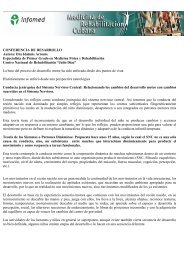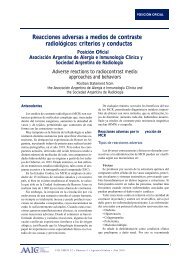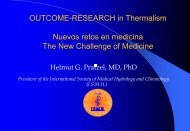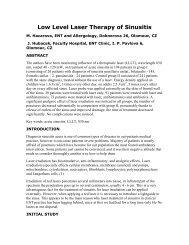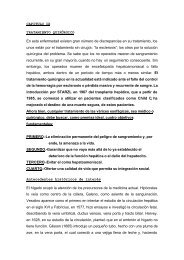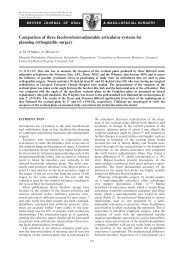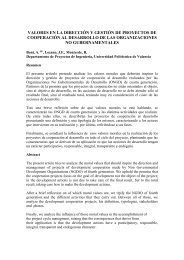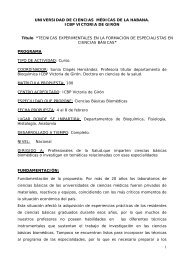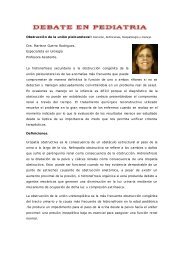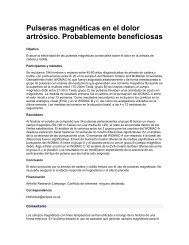pharmacology of medicinal plants and natural products
pharmacology of medicinal plants and natural products
pharmacology of medicinal plants and natural products
You also want an ePaper? Increase the reach of your titles
YUMPU automatically turns print PDFs into web optimized ePapers that Google loves.
S96<br />
S. A. DAHANUKAR et al.,<br />
anti-bacterial properties <strong>of</strong> aromatic oils derived from<br />
<strong>plants</strong> using the agar cup <strong>and</strong> disc diffusion methods.<br />
Hence, Agnihotri <strong>and</strong> Vaidya 165 have to developed<br />
a novel approach to study the anti-bacterial<br />
property <strong>of</strong> certain <strong>plants</strong> like Eugenia caryophyllus,<br />
Thymus vulgaris, Cinnamonum zeylanium <strong>and</strong><br />
Cuminum cyminum. Volatile components <strong>of</strong> the<br />
hexane extracts <strong>of</strong> these <strong>plants</strong> were tested against<br />
st<strong>and</strong>ard gram positive <strong>and</strong> gram negative bacteria<br />
grown on agar slants <strong>and</strong> the results were expressed<br />
as percentage inhibition <strong>of</strong> the area <strong>of</strong> the slants. Of<br />
the 4 <strong>plants</strong> selected, Thymus vulgaris had the most<br />
prominent anti-bacterial activity.<br />
14.2. Anti-fungal agents<br />
The ethanolic extract <strong>of</strong> Azadirachta indica leaves<br />
demonstrated much more significant antidermatophytic<br />
activity as compared to the aqueous<br />
extract, when tested in vitro against 88 clinical isolates<br />
<strong>of</strong> dermatophytes using the agar dilution technique.<br />
The MIC90 <strong>of</strong> ethanolic extract was 100 µg/ml<br />
whereas that <strong>of</strong> aqueous extract was 500 µg/ml 166 .<br />
Four Siddha drugs viz N<strong>and</strong>hi mezhugh, Parangi<br />
pattai choornam, Erasa kenthi mezhugu <strong>and</strong> Vaan<br />
mezhugu (in order <strong>of</strong> efficacy) were found to have<br />
significant anti-fungal activity when tested against 14<br />
strains <strong>of</strong> C<strong>and</strong>ida albicans 167 .<br />
Essential oil obtained from the herb <strong>of</strong> Santolina<br />
chamaecyparissus showed significant anti-fungal<br />
activity both in vitro (against 13 strains <strong>of</strong> C<strong>and</strong>ida<br />
albicans) <strong>and</strong> in vivo (experimentally induced vaginal<br />
<strong>and</strong> systemic c<strong>and</strong>idiasis in mice) 168 . It also<br />
showed activity against experimentally induced superficial<br />
cutaneous mycoses in guinea pigs by the<br />
hair root invasion test 169 . Anti-bacterial activity was<br />
also observed as seen by its inhibitory effects on the<br />
growth <strong>of</strong> Staphylococcus aureus, Bacillus subtitis,<br />
Bacillus caerus <strong>and</strong> Escherichia coli.<br />
Rai 170 screened 17-<strong>medicinal</strong> <strong>plants</strong> against the test<br />
pathogen, Pestalotiopsis mangiferae <strong>and</strong> the results<br />
revealed that 14 <strong>plants</strong> had anti-mycotic activity<br />
whereas 3-<strong>plants</strong>, viz., Argemone mexicana,<br />
Caesalpinia bonducella <strong>and</strong> Casia fistula accelerated<br />
the growth <strong>of</strong> the pathogen. Maximum antimycotic<br />
activity was shown by Eucalyptus globulus (88%) <strong>and</strong><br />
Catharanthus roseus (88%) followed by Ocimum<br />
sanctum (85.50%), Azadirachta indica (84.66%),<br />
Ricinus communis (Er<strong>and</strong>) (75%) <strong>and</strong> Lawsonia inermis<br />
(74.33%) while the minimum activity was exhibited<br />
by Jatropha curcas (10%).<br />
The essential oil isolated from the leaves <strong>of</strong> Aegle<br />
marmelos exhibited significant anti-fungal activity<br />
against different fungal isolates <strong>and</strong> 100% inhibition<br />
<strong>of</strong> spore germination <strong>of</strong> all the tested fungi when<br />
evaluated using the spore germination assay. Kinetic<br />
studies showed that the inhibition was both concentration<br />
as well as time dependent 171 .<br />
Four compounds have been isolated from an extract<br />
prepared from the fruit rind <strong>of</strong> Terminalia belerica viz.<br />
termilignan, thannilignan (both lignans), 7-hydroxy-<br />
3',4'-(methylenedioxy) flavone <strong>and</strong> anolignan B. All<br />
possessed demonstrable anti-HIV-1, anti-malarial,<br />
<strong>and</strong> anti-fungal activity in vitro 172,173 .<br />
The <strong>natural</strong> xanthones isolated from the fruit hulls <strong>of</strong><br />
Garcinia mangostana showed good inhibitory activity<br />
against the three phytopathogenic fungi, Fusarium<br />
vasinfectum, Alternaria tenuis, <strong>and</strong> Dreschlera<br />
oryzae. Substitution in the A <strong>and</strong> C rings in the derivatives<br />
<strong>of</strong> mangostin obtained by has been shown<br />
to modify the bioactivities <strong>of</strong> the compounds 174 .<br />
The petroleum ether, chlor<strong>of</strong>orm, acetone <strong>and</strong> ethanol<br />
(95%) extracts <strong>of</strong> the leaves <strong>of</strong> Cassia alata also<br />
showed significant in vitro anti-fungal activity against<br />
various fungi viz. Aspergillus niger, R. japonicum,<br />
C<strong>and</strong>ida albicans, C. tropiathis <strong>and</strong> R. glutinis 175 .<br />
The root <strong>of</strong> Withania somnifera was found to be effective<br />
in prolonging the survival <strong>of</strong> Balb/c mice infected<br />
intravenously with Apergillus fumigatus. This<br />
protective activity is probably due to the observed<br />
increase in phagocytosis <strong>and</strong> intracellular killing capacity<br />
<strong>of</strong> peritoneal macrophages induced by treatment<br />
with Withania somnifera, thus suggesting that<br />
the plant has the potential to activate macrophage<br />
function in infectious states 176 .<br />
14.3. Anti-viral agents<br />
Although initial studies by Thyagarajan et al, 177 with<br />
Phyllanthus amarus showed promising results in<br />
Hepatitis B carriers, further studies have demonstrated<br />
that the plant does not clear the hepatitis B<br />
surface antigen (HbsAg) in asymptomatic carriers <strong>of</strong><br />
the antigen 178 . However, recently, in an in vitro study,<br />
the aqueous extract <strong>of</strong> Phyllanthus amarus was




